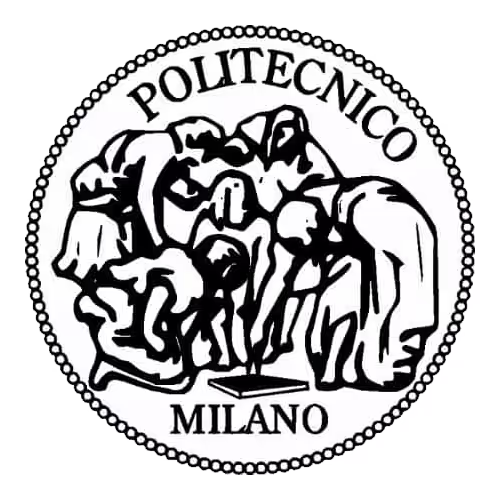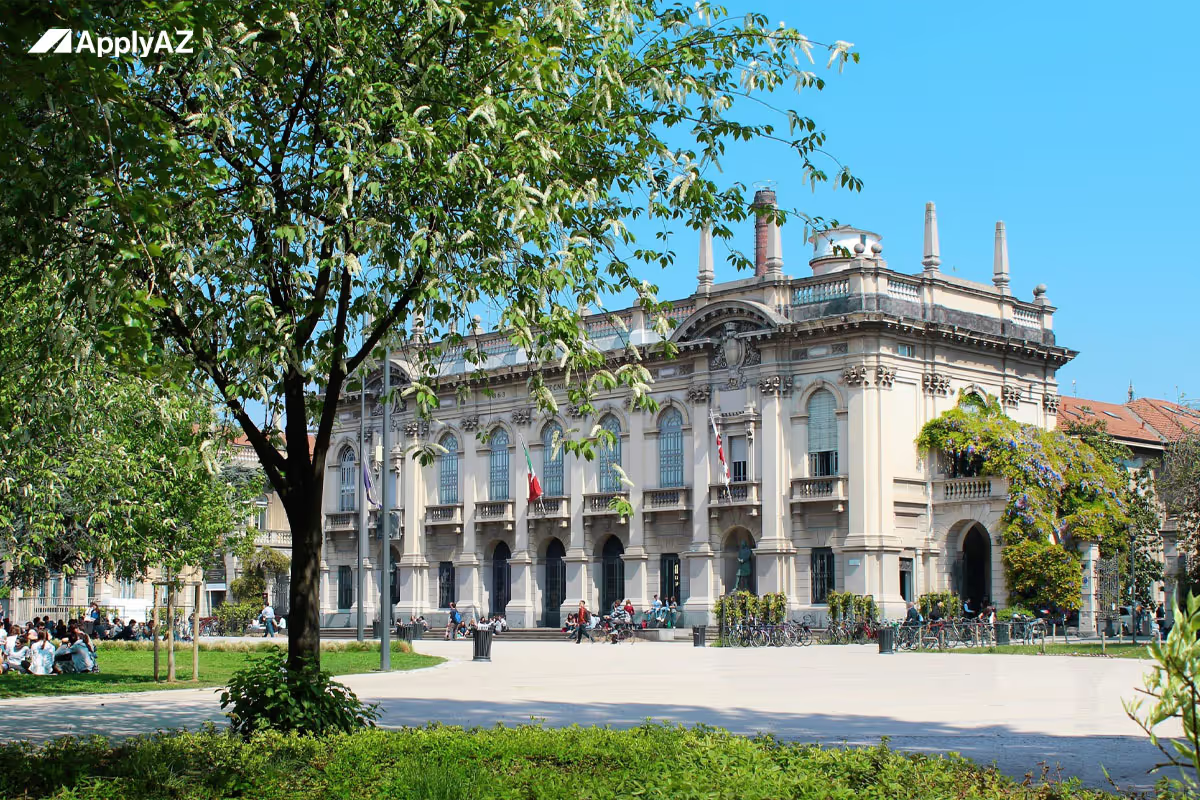Heading
Heading








Study in Italy in English at Polytechnic University of Milan (Politecnico di Milano)
Finding the right place to study in Italy in English can be hard. Yet one name always rises to the top: the Polytechnic University of Milan (Politecnico di Milano). This public Italian university blends 160 years of academic strength with the creative energy of Milan. Below, ApplyAZ explains its history, rankings, scholarships, jobs, and daily life so you can decide if it matches your goals.
A Public Italian University with World-Class Credentials
Politecnico di Milano opened in 1863 and now enrols more than 48 000 students on seven campuses across Lombardy. It ranks close to the world’s top 100 overall, top ten for design, and top twenty for engineering. These results reflect constant investment in staff, laboratories, and international partnerships.
Timeline of Excellence
- 1863: Founded as the Regio Istituto Tecnico Superiore with 30 students.
- 1900–1950: Expanded into civil and mechanical engineering.
- 1960s: Bovisa campus opened; architecture and design schools launched.
- 2000s: English-language master’s degrees introduced to welcome global talent.
- 2020s: Research centres in sustainable mobility, artificial intelligence, and space engineering became European hubs.
Key Departments and Facilities
- Architecture, Urban Planning, Construction Engineering – pioneers in sustainable cities and heritage preservation.
- Design – renowned for product, fashion, and interaction design, tied to Milan Design Week.
- Industrial and Information Engineering – covers aerospace, mechanical, biomedical, automation, and computer science.
- PoliFAB – flagship micro- and nanotechnology laboratory open to start-ups.
- Leonardo Supercomputer Hub – one of Europe’s fastest, supporting climate models and AI research.
The breadth of English-taught programs in Italy offered here lets you combine robotics with medical imaging or architecture with urban sociology. Many courses include double-degree options that add a second diploma abroad without extra fees—rare even among tuition-free universities Italy.
Campus Life and Student Support
Politecnico’s main centres—Città Studi and Bovisa—sit 15 minutes apart by metro. Both mix lecture halls with green courtyards, cafés, and maker spaces. The Welcome Desk guides new students through residence permits, bank accounts, and free Italian courses.
Sports fans find gyms, climbing walls, and five-a-side football pitches, while 100+ clubs cover robotics, Formula Student racing, photography, and debate. A buddy programme pairs newcomers with senior volunteers who help with day-to-day questions.
Milan: A City That Combines History, Creativity, and Career Growth
Milan offers historic elegance and future-focused energy. The city is compact, efficient, and rich in culture, making it ideal for international students.
Climate and Transport
- Mild winters: Average 5 °C in January.
- Warm summers: Around 30 °C in July.
- Affordable transport: A discounted student pass covers metro, tram, and bus for roughly €25 per month.
- Fast connections: High-speed trains reach Rome in three hours; airports offer flights to 200 destinations.
Cost of Living (Typical Monthly Budget)
- Shared flat near campus: €450–600
- University residence with DSU grant: €300–350
- Groceries: €45–60
- Subsidised campus meal: €4
- Mobile and internet: €15
Smart planning keeps total yearly costs below €8 000—especially after fee waivers and the DSU grant.
Student Life and Culture
Evenings can mean jazz in Navigli, gallery openings in Brera, or football at San Siro. Weekends bring skiing in the Alps, sailing on Lake Como, or city trips across Europe. Politecnico’s clubs—and Milan’s international vibe—make it easy to build a global network.
Funding Your Studies: Tuition Waivers and Scholarships
Politecnico di Milano charges variable tuition based on family income. Annual fees range from €0 to about €3 900. Most ApplyAZ students secure large reductions by submitting the ISEE (household income form).
The DSU Grant
The DSU grant, a regional scholarship for international and Italian students, offers:
- Full or partial fee waiver
- Meal vouchers for campus canteens
- Rent support
- Up to €5 200 cash each year
Jobs and Internships in Europe’s Design and Tech Hub
Milan drives Italy’s economy. More than 3 000 multinationals and 2 100 start-ups base their Italian or European offices here. Key sectors include fashion and luxury, design, finance and fintech, technology and AI, automotive and aerospace, green energy, and biomedical devices.
Politecnico’s career service hosts two large fairs each year, runs a job portal with 7 000 listings, and supports new ventures through PoliHub—Italy’s leading university incubator. Internships often pay €700–1 200 per month and count towards your degree. Graduates may convert their residence permit into a “job-seeking visa,” giving 12 months to find full-time work.
Living and Learning Across Multiple Campuses
- Città Studi: Historic centre for civil, chemical, and environmental engineering.
- Bovisa: Modern site with design studios, wind tunnels, and micro-electronics clean rooms.
- Piacenza, Lecco, Mantova, Cremona, Como: Smaller hubs perfect for focused research and lakeside relaxation.
In two minutes we’ll confirm whether you meet the basic entry rules for tuition-free, English-taught degrees in Italy. We’ll then quickly see if we still have space for you this month. If so, you’ll get a personalised offer. Accept it, and our experts hand-craft a shortlist of majors that fit your grades, goals, and career plans. Upload your documents once; we submit every university and scholarship application, line up multiple admission letters, and guide you through the visa process—backed by our admission-and-scholarship guarantee.
Mechanical Engineering at the Polytechnic University of Milan (Politecnico di Milano)
Mechanical Engineering at Politecnico di Milano—study in Italy in English, pay low public-university fees, and access strong industry links.
Why an English-taught program in Italy is a smart move
English-taught programs in Italy combine respected European degrees with living costs far lower than many other study destinations. The Mechanical Engineering bachelor (L-9) at the Polytechnic University of Milan (Politecnico di Milano) lets you study in Italy in English while using world-class labs in materials, robotics, and energy. Because Politecnico is a public Italian university, its tuition is already modest—and the DSU grant plus other scholarships for international students in Italy can make your net cost feel close to tuition-free universities Italy.
Course overview: learn by designing, testing, and building
What you study
- Core theory in calculus, physics, thermodynamics, and mechanics.
- Hands-on labs for materials testing, CNC machining, and 3-D printing.
- Project modules that ask teams to redesign a bicycle frame, build a solar-powered mini car, or optimise a heat-pump cycle.
- Electives in aerospace structures, renewable energy, or industrial automation.
All lectures, reports, and exams are in English. Free evening classes take you from basic to conversational Italian—handy for internships and daily life.
Industry exposure
Guest engineers from Ferrari, Pirelli, Siemens, and ABB visit workshops each term. The university hosts two career fairs a year, and over 7,000 internship offers appear on the student portal. Many placements start in English; you can add Italian later.
Life in Milan while you study in Italy in English
- Accommodation: Shared flats cost €350–€450 per month. DSU housing drops to about €250.
- Transport: A €27 student pass covers metro, tram, and bike share.
- Living costs: Around €900 monthly, including food and leisure.
- Climate: Hot summers, mild winters—good for outdoor projects and weekend trips.
- Culture: Explore Design Week, Serie A football, and museums that offer student discounts. Fast trains reach Venice in two hours and Rome in three.
Funding: approaching tuition-free universities Italy
You can combine several aids:
- DSU grant – removes tuition and adds up to €6,600 a year for living costs.
- Merit awards – full or half tuition waivers for high SAT, ACT, or TOLC-I scores.
- ISEE brackets – families earning under €23,000 pay no tuition.
- Women in STEM bursary – €8,000 per year for top female applicants.
- Erasmus+ stipend – €350–€450 a month during an exchange semester.
Key dates and simple admission steps
- 1 November: online application opens—upload transcripts, passport, and English score.
- 15 January: early deadline; early birds get better scholarship odds.
- 31 March: final call for non-EU visa applicants.
- May–June: file DSU grant forms after you receive your admission letter.
- July–August: attend your visa interview with proof of funding.
- Early September: arrive for welcome week and a short Italian crash course.
Your career outlook
Mechanical Engineering graduates enter roles such as:
- Automotive drivetrain engineer for Stellantis.
- Energy analyst modelling hydrogen pipelines.
- Robotics application engineer at ABB.
- Aerospace project officer on satellite thermal systems.
- Manufacturing consultant implementing lean processes.
Ninety-five percent of alumni secure a job or master’s place within six months. The 2024 average starting salary was €38,000, with higher figures in automotive and aerospace.
Ready for this programme?
If you qualify and we still have a spot this month, we’ll reserve your place with ApplyAZ. Our team will tailor a set of best-fit majors—including this course—and handle every form and deadline for you. One upload, many applications, guaranteed offers, DSU grant support, and visa coaching: that’s the ApplyAZ promise. Start now and secure your spot before this month’s intake fills up.

They Began right where you are










